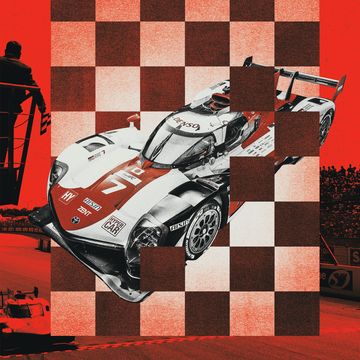Robert Bull, Bob to his friends, was sitting in the grandstand behind the pit area as the 1955 24 Hours of Le Mans ran through its 35th lap. He was 17 and, like all spectators, separated from the action by only a low earthen berm. Mike Hawthorn was, at that moment, entering the pits behind the wheel of the leading Jaguar.
This story originally appeared in Volume 16 of Road & Track.
Relying on his D-type’s powerful new disc brakes, Hawthorn stopped at the last possible moment. This caused the Austin-Healey 100S he had just lapped, driven by fellow Brit Lance Macklin, to move across the track, directly into the path of a much faster Mercedes-Benz 300 SLR being driven by 49-year-old Frenchman Pierre Levegh.
Traveling at around 125 mph, the Mercedes hit the back of Macklin’s slope-tailed Healey and was launched over the berm. The magnesium-bodied SLR disintegrated and burst into flames, with various parts, including its straight-eight engine, tumbling through a tightly packed standing crowd for more than 300 feet.
It was the deadliest crash ever in motor racing, killing at least 83 spectators and injuring many more. The disaster’s repercussions went far beyond the circuit, with several European countries banning all motorsport in its aftermath. Switzerland still bans most racing.
Bob Bull, an Englishman, is now 85 and one of the few eyewitnesses left. Or, as he explains with characteristically dry British wit, “I was 17 then, so old enough to be there but young enough to still be alive.”
The visit to Le Mans was Bull’s first trip abroad, an early 18th-birthday present for a racing-mad teenager, arranged as a surprise by his parents. “I came home from work one Friday, and my mum said I needed to have an early night, because I was going to Le Mans in the morning,” he says. “I didn’t believe her at first, but they had organized the whole thing without me realizing it.”
Bull’s group flew to Le Mans from England—his first time on an airplane—and then walked into the track. A pre-race visit to the paddock gave him the chance to get close to stars, including his hero, Hawthorn, and then they took their seats in the Guy Bouriat stand, directly opposite the Jaguar pit.
“It was the famous Le Mans start, the drivers running across the track,” Bull says, “and I remember Hawthorn and Fangio soon got into a tremendous duel, setting new lap records.
“[Eugenio] Castellotti came along in the Ferrari, and I followed him up the road,” Bull says. “Then I turned my head back to catch Fangio or Hawthorn, and that’s when I saw this huge ball of flame. I can still see it vividly. The next thing I remember was standing at the back of the grandstand. I’d been close to the front in the middle of a row, and I haven’t got the faintest notion how I got back there. I must have pushed past lots of people. There was a hush, as if everybody knew something terrible had happened. The thought that went through my mind was ‘I mustn’t get killed because it would upset mum.’”
Shockingly, the race continued, even as the remains of Levegh’s Mercedes burned on the banking and his body lay on the ground next to it. Although just feet from the disaster, Bull had no idea of the scale of the human tragedy below him.
“Down in front of the grandstand we could see the Mercedes on the barrier—well, bits of it—but mainly I remember seeing rescue workers dealing with the injured, the ground covered with personal possessions and bits of debris,” he says.
“It was just too much to take in; your mind blanks it out,” Bull says. “I’ve got snapshots, if that makes sense, but not a video of what happened.”
Bull later returned to the paddock through the tunnel under the main straight. “This was after the dead and injured had been taken away, but the walls near the entrance were splattered with what looked like bits of mincemeat. I remember not wanting to know what it was, but it must have been bits of flesh.”
Looking back, Bull agrees with the decision not to stop the race—had 250,000 spectators tried to leave, they would undoubtedly have impeded rescue efforts. Mercedes withdrew its remaining cars several hours later and then, by the end of the season, abandoned racing altogether, a decision that lasted nearly 30 years. Jaguar opted to race to the finish. Hawthorn and Ivor Bueb won by five laps—with Hawthorn criticized for drinking champagne on the podium.
The debate over responsibility for the crash has continued ever since—Hawthorn’s dive into the pits, Macklin’s evasive maneuver, and Levegh’s dulled reaction have all been blamed. But the primary cause was certainly the primitive circuit design.
Officials hastily commissioned a new pit-lane complex with a dedicated deceleration lane at Le Mans in time for the 1956 race, with other circuits gaining sturdier barriers and ditches. Levegh’s American teammate, John Fitch, witnessed the crash from the pit wall and became a safety pioneer. The yellow sand-filled Fitch barriers he invented are now a common sight next to the world’s highways and have surely saved countless lives.
Bull didn’t discover how many people had died until he read the following day’s newspapers after returning to the U.K. He never went back to Le Mans, although not for the reason you might imagine.
“I found the race a bit boring,” he says. “I wasn’t able to follow the action properly, which wasn’t like the smaller tracks I had visited in the U.K.”
It didn’t put him off motorsport, though. His enthusiasm eventually led him to a part-time career as a photographer and journalist. He still takes pictures at races and is a contributor to a Morgan magazine.
Of his experience of that long-ago disaster, he remains phlegmatic: “It was a terrible crash, the worst one ever, but when you go to a race, it says ‘motorsport is dangerous’ on the ticket. I was always willing to accept that.”


















